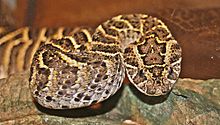| Puff adder | |
|---|---|

| |
| Scientific classification | |
| Domain: | Eukaryota |
| Kingdom: | Animalia |
| Phylum: | Chordata |
| Class: | Reptilia |
| Order: | Squamata |
| Suborder: | Serpentes |
| Family: | Viperidae |
| Genus: | Bitis |
| Species: | B. arietans
|
| Binomial name | |
| Bitis arietans (Merrem, 1820)
| |

| |
| Distribution range[1] | |
| Synonyms | |
|
Click to expand
| |
The puff adder (Bitis arietans) is a highly venomous viper species found in savannahs and grasslands from Morocco and western Arabia throughout Africa except for the Sahara and rainforest regions.[3] It is responsible for causing the most snakebite fatalities in Africa owing to various factors, such as its wide distribution, frequent occurrence in highly populated regions, and aggressive disposition.[4][5] Like all other vipers, it is venomous. Two subspecies are currently recognized, including the nominate subspecies described here.[6]
The species is commonly known as the puff adder,[4][7] African puff adder,[8][9] or common puff adder.[10]
- ^ a b Wagner, P.; Wilms, T.; Luiselli, L.; Penner, J.; Rödel, M.-O.; Els, J.; Al Johany, A.M.H.; Egan, D.M.; Beraduccii, J.; Howell, K.; Msuya, C.A.; Ngalason, W.; Turner, A.A.; Zassi-Boulou, A.-G.; Kusamba, C.; Chippaux, J.-P. (2021). "Bitis arietans". IUCN Red List of Threatened Species. 2021: e.T197461A2485974. doi:10.2305/IUCN.UK.2021-3.RLTS.T197461A2485974.en.
- ^ McDiarmid RW, Campbell JA, Touré T. 1999. Snake Species of the World: A Taxonomic and Geographic Reference, Volume 1. Herpetologists' League. 511 pp. ISBN 1-893777-00-6 (series). ISBN 1-893777-01-4 (volume).
- ^ U.S. Navy. 1991. Venomous Snakes of the World. US Govt. New York: Dover Publications Inc. 203 pp. ISBN 0-486-26629-X.
- ^ a b Mallow D, Ludwig D, Nilson G. 2003. True Vipers: Natural History and Toxinology of Old World Vipers. Krieger Publishing Company, Malabar, Florida. 359 pp. ISBN 0-89464-877-2.
- ^ Spawls S, Howell K, Drewes R, Ashe J. 2004. A Field Guide to the Reptiles of East Africa. A & C Black Publishers Ltd., London. 543 pp. ISBN 0-7136-6817-2.
- ^ "Bitis arietans". Integrated Taxonomic Information System. Retrieved 24 July 2006.
- ^ Spawls S, Branch B. 1995. The Dangerous Snakes of Africa. Ralph Curtis Books. Dubai: Oriental Press. 192 pp. ISBN 0-88359-029-8.
- ^ Fichter GS. 1982. Venomous Snakes. (A First Book). Franklin Watts. 66 pp. ISBN 0-531-04349-5.
- ^ Kauffeld C. 1969. Snakes: The Keeper and the Kept. Garden City, New York: Doubleday & Company, Inc. 248 pp. LCCCN 68-27123.
- ^ Bitis arietans at Munich AntiVenom INdex. Accessed 2 August 2007.
